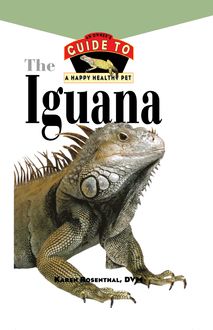Leopard Gecko , livre ebook
110
pages
English
Ebooks
2007
Vous pourrez modifier la taille du texte de cet ouvrage
Obtenez un accès à la bibliothèque pour le consulter en ligne En savoir plus
Découvre YouScribe en t'inscrivant gratuitement
Découvre YouScribe en t'inscrivant gratuitement
110
pages
English
Ebooks
2007
Vous pourrez modifier la taille du texte de cet ouvrage
Obtenez un accès à la bibliothèque pour le consulter en ligne En savoir plus
Publié par
Date de parution
17 juillet 2007
Nombre de lectures
1
EAN13
9780470130896
Langue
English
Poids de l'ouvrage
2 Mo
Leopard geckos are attractive and easy to care for, making them popular pets. There's lots to know before you bring home a gecko, and this guide fills you in with information on:
- Choosing your Leopard gecko
- Must-have supplies
- Setting up and equipping your vivarium
- Feeding, handling, and caring for your pet
- Breeding geckos and hatching and raising babies
Leopard geckos can live twenty years or more, so be sure you're ready to commit to your fascinating creature. You'll enjoy years of slinky live entertainment.
Part I: The Leopard Gecko’s World.
Chapter 1: What Is a Gecko?
Lizards as Pets.
How Geckos Are Like Other Reptiles.
How Geckos Are Different.
Humans and Geckos.
Chapter 2: What Makes the Leopard Gecko Special?
All in the Subfamily.
Natural Habitat of the Leopard Gecko.
Is a Leopard Gecko the Right Pet for You?
The Perfect Lizard Pet.
Chapter 3: Colors, Patterns, and Phases.
The Language of Variation.
Part II: Caring for Your Leopard Gecko.
Chapter 4: Choosing Your Leopard Gecko.
Where to Shop.
The Ideal Age.
Re-grown Tails.
When You’ve Chosen Your Leopard Gecko.
Environmental Ethics.
Captive Bred vs. Wild Caught.
Chapter 5: Housing Your Leopard Gecko.
The Vivarium.
Understanding and Avoiding Salmonella.
Building a Custom Habitat.
Cleaning Your Leopard Gecko’s Habitat.
Chapter 6: Feeding Your Leopard Gecko.
What to Feed.
How to Feed.
Vitamins and Minerals.
How to Keep and Gut Load Crickets.
Wild-Caught Invertebrates.
Water.
Chapter 7: Keeping Your Leopard Gecko Healthy.
Choosing a Veterinarian.
Common Health Problems.
Part III: Behavior and Breeding.
Chapter 8: Your Leopard Gecko’s Behavior.
Hunting.
Shedding.
Territoriality.
Home Alone.
Mating.
Nesting.
Hiding.
Your Gecko’s Personality.
The Outside World.
Change of Seasons.
Handling a Leopard Gecko.
Chapter 9: Breeding Leopard Geckos.
Sexing Leopard Geckos.
Breeding Age.
The Right Time of Year.
The Mating.
Chapter 10: Hatching and Raising Baby Geckos.
Choosing an Incubation Medium.
Choosing Egg Containers.
Moving the Eggs.
Caring for the Eggs.
Maintaining Moisture Levels during Incubation.
Maintaining Proper Temperatures.
The Hatching.
Raising Young Leopard Geckos.
Appendix: Learning More About Your Leopard Gecko.
Some Good Books.
Magazines.
Herpetological Societies.
Internet Resources.
Index.
Publié par
Date de parution
17 juillet 2007
Nombre de lectures
1
EAN13
9780470130896
Langue
English
Poids de l'ouvrage
2 Mo
This book is printed on acid-free paper.
Copyright © 2007 by Wiley Publishing, Inc., Hoboken, New Jersey. All rights reserved.
Howell Book House
Published by Wiley Publishing, Inc., Hoboken, New Jersey
No part of this publication may be reproduced, stored in a retrieval system or transmitted in any form or by any means, electronic, mechanical, photocopying, recording, scanning or otherwise, except as permitted under Sections 107 or 108 of the 1976 United States Copyright Act, without either the prior written permission of the Publisher, or authorization through payment of the appropriate per-copy fee to the Copyright Clearance Center, 222 Rosewood Drive, Danvers, MA 01923, (978) 750-8400, fax (978) 646-8600, or on the web at www.copyright.com . Requests to the Publisher for permission should be addressed to the Legal Department, Wiley Publishing, Inc., 10475 Crosspoint Blvd., Indianapolis, IN 46256, (317) 572-3447, fax (317) 572-4355, or online at http://www.wiley.com/go/permissions .
Wiley, the Wiley logo, Howell Book House, the Howell Book House logo, Your Happy Healthy Pet, and related trade dress are trademarks or registered trademarks of John Wiley & Sons, Inc. and/or its affiliates in the United States and other countries, and may not be used without written permission. All other trademarks are the property of their respective owners. Wiley Publishing, Inc. is not associated with any product or vendor mentioned in this book.
The publisher and the author make no representations or warranties with respect to the accuracy or completeness of the contents of this work and specifically disclaim all warranties, including without limitation warranties of fitness for a particular purpose. No warranty may be created or extended by sales or promotional materials. The advice and strategies contained herein may not be suitable for every situation. This work is sold with the understanding that the publisher is not engaged in rendering legal, accounting, or other professional services. If professional assistance is required, the services of a competent professional person should be sought. Neither the publisher nor the author shall be liable for damages arising here from. The fact that an organization or Website is referred to in this work as a citation and/or a potential source of further information does not mean that the author or the publisher endorses the information the organization or Website may provide or recommendations it may make. Further, readers should be aware that Internet Websites listed in this work may have changed or disappeared between when this work was written and when it is read.
For general information on our other products and services or to obtain technical support please contact our Customer Care Department within the U.S. at (800) 762-2974, outside the U.S. at (317) 572-3993 or fax (317) 572-4002.
Wiley also publishes its books in a variety of electronic formats. Some content that appears in print may not be available in electronic books. For more information about Wiley products, please visit our web site at www.wiley.com .
Library of Congress Cataloging-in-Publication Data:
Indiviglio, Frank.
Leopard gecko / Frank Indiviglio. - 2nd ed.
p. cm. - (Your happy healthy pet)
Includes bibliographical references and index.
ISBN 978-0-470-03792-8 (cloth : alk. paper)
1. Leopard geckos as pets. I. Title.
SF459.G35I53 2007
639.3'952-dc22
2007002524
Printed in the United States of America
10 9 8 7 6 5 4 3 2 1
2nd Edition
Book design by Melissa Auciello-Brogan
Cover design by Michael J. Freeland
Book production by Wiley Publishing, Inc. Composition Services
Wiley Bicentennial Logo: Richard J. Pacifico
About the Author
Frank Indiviglio is a biologist and environmental lawyer who has spent most of his life working with animals at the Bronx and Staten Island Zoos in New York City. His field research projects in Latin America have involved animals ranging from anacondas to leatherback turtles, and he has been a biology and natural history teacher at Science Development, Inc., and Columbia Preparatory School in Manhattan.
Frank tends to focus on the “less appreciated” animal species but is interested in them all. He has written four books and numerous magazine articles on the captive care and natural history of invertebrates, fishes, amphibians, reptiles, birds, and mammals.
About Howell Book House
Since 1961, Howell Book House has been America’s premier publisher of pet books. We’re dedicated to companion animals and the people who love them, and our books reflect that commitment. Our stable of authors-training experts, veterinarians, breeders, and other authorities-is second to none. And we’ve won more Maxwell Awards from the Dog Writers Association of America than any other publisher.
As we head toward the half-century mark, we’re more committed than ever to providing new and innovative books, along with the classics our readers have grown to love. This year, we’re launching several exciting new initiatives, including redesigning the Howell Book House logo and revamping our biggest pet series, Your Happy Healthy Pet TM , with bold new covers and updated content. From bringing home a new puppy to competing in advanced equestrian events, Howell has the titles that keep animal lovers coming back again and again.
Contents
Part I: The Leopard Gecko’s World
Chapter 1: What Is a Gecko?
Lizards as Pets
How Geckos Are Like Other Reptiles
How Geckos Are Different
Humans and Geckos
Chapter 2: What Makes the Leopard Gecko Special?
All in the Subfamily
Natural Habitat of the Leopard Gecko
Is a Leopard Gecko the Right Pet for You?
The Perfect Lizard Pet
Chapter 3: Colors, Patterns, and Phases
The Language of Variation
Part II: Caring for Your Leopard Gecko
Chapter 4: Choosing Your Leopard Gecko
Where to Shop
The Ideal Age
Re-grown Tails
When You’ve Chosen Your Leopard Gecko
Environmental Ethics
Captive Bred vs. Wild Caught
Chapter 5: Housing Your Leopard Gecko
The Vivarium
Understanding and Avoiding Salmonella
Building a Custom Habitat
Cleaning Your Leopard Gecko’s Habitat
Chapter 6: Feeding Your Leopard Gecko
What to Feed
How to Feed
Vitamins and Minerals
How to Keep and Gut Load Crickets
Wild-Caught Invertebrates
Water
Chapter 7: Keeping Your Leopard Gecko Healthy
Choosing a Veterinarian
Common Health Problems
Part III: Behavior and Breeding
Chapter 8: Your Leopard Gecko’s Behavior
Hunting
Shedding
Territoriality
Home Alone
Mating
Nesting
Hiding
Your Gecko’s Personality
The Outside World
Change of Seasons
Handling a Leopard Gecko
Chapter 9: Breeding Leopard Geckos
Sexing Leopard Geckos
Breeding Age
The Right Time of Year
The Mating
Chapter 10: Hatching and Raising Baby Geckos
Choosing an Incubation Medium
Choosing Egg Containers
Moving the Eggs
Caring for the Eggs
Maintaining Moisture Levels during Incubation
Maintaining Proper Temperatures
The Hatching
Raising Young Leopard Geckos
Appendix: Learning More About Your Leopard Gecko
Some Good Books
Magazines
Herpetological Societies
Internet Resources
Index
The Leopard Gecok
Chapter 1
What Is a Gecko?
G eckos are lizards. When it comes to diversity, lizards are the most successful of the reptiles-nearly 4,000 species have been described.
The family of lizards to which the Leopard gecko belongs is known as the Gekkonidae. This incredibly diverse and successful group of lizards contains more than 800 species, with new ones being described by scientists each year. It’s a complicated family with many interesting twists and turns. The level of diversity in this one branch of lizards is so complex and specialized that it can inspire and dazzle. This complexity makes geckos very exciting to study and to keep as pets.
Geckos live in many types of habitats around the world, ranging from searing, dry deserts to lush, cool mountain forests. There are many different types of geckos. The most exciting thing about geckos is their diversity. Some are unique, odd creatures. Some are virtual living jewels.
Geckos have been successful in colonizing the globe because they are able to exploit many types of habitats. Many gecko species have adapted to highly specialized niches in their surroundings, which are called microhabitats. For example, a South African Rhotropus species can live exclusively in rock cracks, while another species lives exclusively on the ground. Both species inhabit the same location, each exploiting specific microhabitats.
Some types of geckos are found only in the wild, while others turn up in pet shops or are offered by breeders.
Is a Lizard Right for You?
• How much space are you willing to devote to your lizard’s cage?
• Can you afford the costs associated with lizard ownership, including food, equipment, electricity, and veterinary care?
• If you will have more than one lizard, do you have room to house them separately, if necessary?
• Will you be willing to feed your lizard insects?
• Will you be able to provide your pet with a varied and nutritious diet?
• Is a reptile veterinarian available nearby?
• Will your children and other family members be willing to learn how to properly care for a delicate lizard?
• Who will care for your lizard while you are away on business or vacation?
• Can you commit to caring for a pet who may live for more than 20 years?
• Does the risk of Salmonella present a special threat to anyone in your household (see page 58 for more on Salmonella)?
• Will dogs, cats, or other pets be a threat to your lizard?
Lizards as Pets
No one knows exactly when human beings began keeping lizards as pets, but we can surmise that the practice started a long time ago. It is clear from both art and scientific literature that humans have been fascinated by lizards for thousands of years. Lizar














